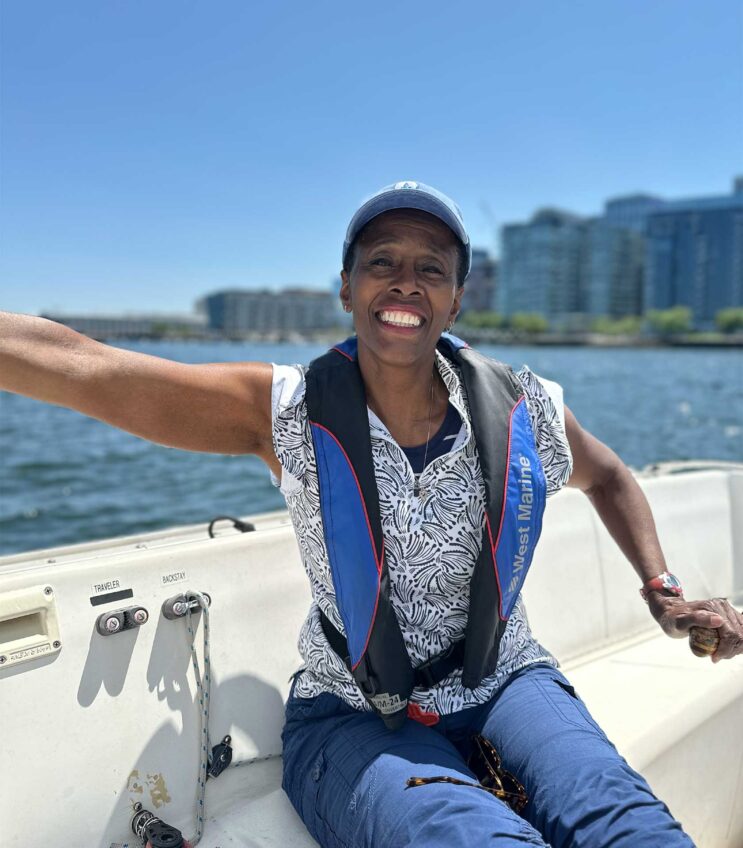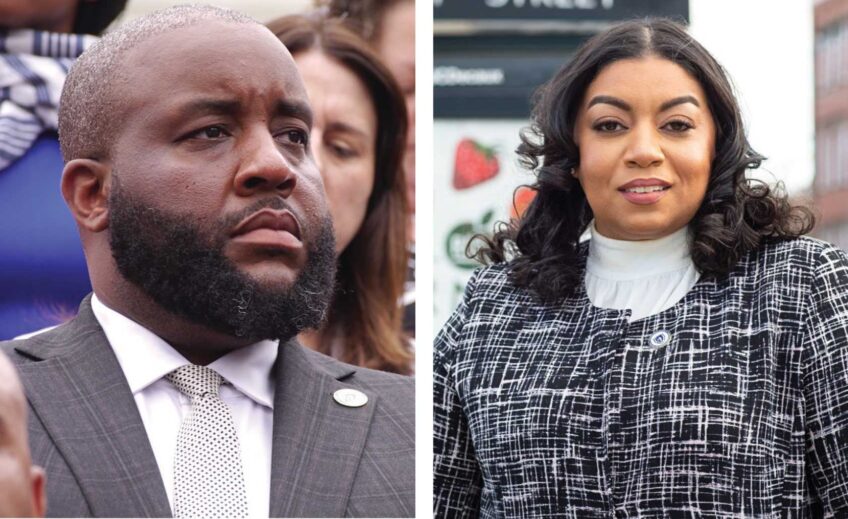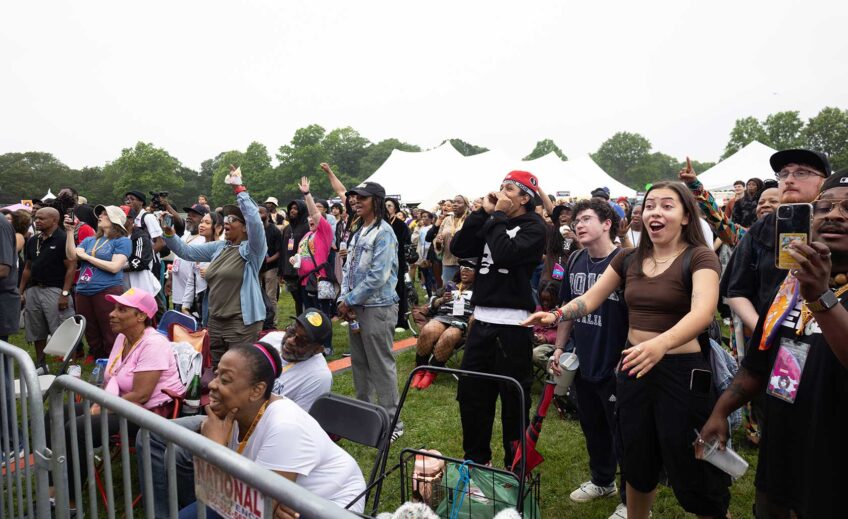EDITOR’S NOTE: Monday, May 19, would have marked the 83rd birthday of the man born Malcolm Little, reborn El-Hajj Malik El-Shabazz, and known the world over as Malcolm X. In commemoration of the date, the Banner republishes here Pulitzer Prize-winning journalist Kenneth J. Cooper’s Feb. 2006 article on the historical figure’s time in Boston.
After a long trip from Michigan, the red-haired teenager stepped down from the Greyhound bus, starting his walk into history with those first steps at the terminal at Park Square in Boston.
The dozen years he spent living in Massachusetts prepared Malcolm Little to become Malcolm X, the black Muslim feared in his own time but so respected in death that an Ivy League college, Columbia University, established a research center to study his life.
It was here in Boston that he went from being a partying teenager who couldn’t keep a job to a street hustler who got busted and imprisoned as inmate number 22843. Behind the bars of Massachusetts prisons, he educated and remade himself into a disciplined, religious man with the backbone to stand up for his people.
More than a half century after he moved away from Boston, there are still many places in and around the city where anyone can look at and say, “Malcolm was here.”
When he arrived in Boston, either in 1940 or 1941, according to various accounts, Malcolm Little was no more than 16 and went to live with his older half-sister, Ella Little Collins. Her two-floor house at 72 Dale Street in Roxbury still stands, and has been declared a historical landmark by both the City of Boston and the Commonwealth of Massachusetts.
Born in Omaha, Neb., and raised until his arrival here in the smaller cities of Milwaukee, Wis., and Lansing and Mason, Mich., Malcolm had been dazzled by the bright lights of “downtown Roxbury” — apparently Dudley Square — when he visited his half-sister the previous summer.
“I didn’t know the world contained as many Negroes as I saw thronging downtown Roxbury at night, especially on Saturdays,” Malcolm X wrote in his 1964 autobiography, co-authored by Alex Haley. “Neon lights, nightclubs, poolhalls [sic], bars, the cars they drove! Restaurants made the streets smell-rich, greasy, down-home black cooking. Jukeboxes blared Erskine Hawkins, Duke Ellington, Cootie Williams, dozens of others.”
With only an eighth-grade education, he bounced from one menial job to another. One was part-time at a parking lot owned by an in-law of Ella Little Collins, Walker’s Auto Parks Company, which was in Chinatown. Rodnell P. Collins, Ella’s son, wrote in his 1998 book, “Seventh Child: A Family Memoir of Malcolm X,” that she got Malcolm a job there on his second day in Boston and he was working there when imprisoned on burglary charges in 1946.
For a time he worked at the Roseland State Ballroom, which had separate lindy hop dances for whites and blacks on different nights, shining shoes in the men’s room — including those of Duke Ellington, who frequently performed there.
The ballroom was on Massachusetts Avenue, where the Christian Science Plaza is located today. Malcolm told an amused Ella he quit that job because “I couldn’t find time to dance and shine shoes, too.”
Another place he hung out was the Savoy Café, a jazz club that used to be at 410 Massachusetts Avenue, just west of Columbus Avenue.
He found other work as a soda jerk at the Townsend Drug Store, which no longer exists but was in Roxbury on Humboldt Avenue at the intersection with Townsend Street; as a busboy at the (Omni) Parker House in downtown Boston; and as a packer at the Sears, Roebuck and Co. warehouse in the Fenway, where the Landmark Center is now located at the intersection of Brookline Avenue, Boylston Street and Park Drive.
For about a year ending in 1943, Malcolm worked as a Pullman porter for the New Haven Railroad, washing dishes and serving coffee and sandwiches to passengers on trains from South Station to Washington, D.C., and New York City. He wrote in his autobiography that he was so good at selling sandwiches that his fellow Pullman porters called him “Sandwich Red.”
Before he got a job aboard trains, he loaded food supplies on to them at the old Dover Street Yards in South Boston, according to his autobiography.
He spent another year in a Pullman job with the Seaboard Railroad on long-haul trains to St. Petersburg and Miami, Fla., renting pillows to passengers and cleaning the cars.
The railroad jobs introduced a teenage Malcolm to Harlem, N.Y., which he found even more dazzling than Roxbury, and then to the street life. He moved to Harlem in 1943 and hustled there.
When he returned to Boston the next year, he lived in Roxbury with his friend and partner in crime, Malcolm “Shorty” Jarvis. Malcolm Little’s first arrest came in November 1944 in Boston for stealing and pawning an aunt’s fur coat, valued at $250, according to his criminal record. He got a suspended sentence of three months and a year of probation.
Malcolm peddled cocaine and gambled big in poker games until he hit upon a criminal idea he figured would reap greater returns — breaking into the homes of the well-to-do. The white girlfriends of both Malcolm and Shorty, and a black man who waited on tables at exclusive parties, cased the houses. They used as a base of operations a ground-floor apartment near Harvard Square, according to “The Autobiography of Malcolm X.”
His life of crime ended in January 1946, when he tried to pick up a stolen watch that he had left for repair at a jewelry store in Roxbury. The owner had reported that a watch with a broken crystal had been taken in a Christmastime burglary in Milton, and police had alerted all jewelers in Boston. Detectives were waiting for him two days later when Malcolm returned. He made a prudent decision not to resist arrest, probably preventing him from being killed in a shootout. The whole crew, except the waiter, got busted.
Malcolm Little was prosecuted twice, on charges of breaking and entering and larceny, in Middlesex Superior Court in East Cambridge for burglaries in Belmont and in Norfolk Superior Court in Dedham for others in Milton.
During the trials, he was held in the Norfolk House of Correction in Dedham. Within six weeks, he had pleaded guilty to seven counts and was sentenced on each, 6 to 8 years or 8 to 10 years of hard labor, to be served concurrently.
In his autobiography, Malcolm wrote about his suspicions that he and Shorty got a high bail — $10,000 — and an overly long sentence because they had been consorting with white women.
The first stop for Malcolm, then 20, was the aging Charlestown State Prison, which was built in 1805 and torn down in 1957. It used to be where Bunker Hill Community College is today. He later did stints at what are now MCI-Concord and MCI-Norfolk.
During much of his year at Charlestown, Malcolm was so foul-mouthed that other inmates nicknamed him “Satan.” But he began to turn his life around, first taking a correspondence course in English and then one in Latin.
At Concord, several of his siblings sent letters in 1948 urging him to do as they had, and join the Nation of Islam and follow Elijah Muhammad’s strictures against eating pork and smoking. He promptly gave up both, inspired by one brother’s promise it would help him get out of prison. Late that year, his half-sister Ella succeeded in winning his transfer to Norfolk, which he described in his autobiography as “an experimental rehabilitation” prison at that time.
Norfolk had an outstanding library, and Malcolm devoured its books, from the “The Souls of Black Folk” by W.E.B. DuBois to John Milton’s epic poem “Paradise Lost.” He copied an entire dictionary. He joined the debate team. Contemplation and correspondence with his siblings drew him deeper into the teachings of Elijah Muhammad.
His last year in prison was back in Charlestown, transferred there, Malcolm suspected, because of the content of his letters.
In August 1952, after six and a half years inside the Commonwealth’s prisons, Malcolm Little was released on parole. He moved to Detroit, joined the Nation of Islam and changed his name to Malcolm X.
A transformed Malcolm visited Boston often to see his relatives and spread the teachings of Elijah Muhammad. Some accounts credit him with founding Muhammad’s Mosque No. 11 in Roxbury and serving as its minister in 1953 and 1954, but Minister Don Muhammad, the mosque’s longtime leader, said in a February 2006 interview that those accounts are inaccurate.
Minister Muhammad joined the Roxbury mosque in 1957 and said Malcolm did oversee the temple’s activities in his role as a regional minister over mosques from Philadelphia to Boston. At the same time, he was leader of the Harlem mosque.
“He was never the minister,” Don Muhammad said. “Malcolm was in Boston quite often. He did not do so much preaching. He came to represent Mister [Elijah] Muhammad in public forums … and public gatherings.”
Muhammad said Malcolm was a frequent guest on a late-night talk show, the first hosted in Boston by the late Jerry Williams. His ratings apparently shot up whenever the provocative Malcolm was on the show, which began in 1957 and was broadcast live on WMEX 1510 AM from studios in Fenway Park.
“Jerry became very popular because of Malcolm’s presence,” he said. It is undisputed that Malcolm founded Mosque No. 13 in Springfield.
Muhammad is one of about a half-dozen senior members of Mosque No. 11 who had contact with Malcolm when he was a leader of the Nation of Islam. Through them, and the places he frequented, the memory of Malcolm X lives in the Boston area, more than four decades after his death at the hands of assassins in Harlem’s Audubon Ballroom on Feb. 21, 1965.






